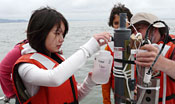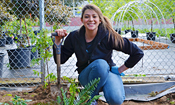You are here
Classes
|
|
Check out some of the classes and camps that have been taught in recent years!
- Oceanography Camp
- Ocean Technology Camp
- The Secret Lives of Microbes Class
- Aquatic Microbiology Class
- Tsunami Camp
Oceanography
Experience firsthand the latest in ocean science research and technology. Join research scientists for a day on the Columbia River estuary to investigate the impact of chemical changes in the ocean environment. You will learn scientific sampling and filtering procedures as you collect water samples, both aboard a scientific research vessel and on shore. Back in the lab, perform chemical analysis of the samples and extract DNA and RNA to identify the microorganisms present. Then, assess levels of chlorophyll, phytoplankton, and nutrients in the water. You will learn about the ocean observing platforms within the Columbia River estuary, what data is collected, and how the data may be used by researchers. You will also see visualizations of the data and learn the fundamentals of computer modeling.
Ocean Technology
Our oceans are under increasing threat from human and climate stress. Experience how oceanographers investigate these changes and communicate them to the scientific community and public at large. Work with professional research scientists and explore the inner workings of SATURN, one of the world’s leading ocean observatories. SATURN is deployed for the study and management of the mighty Columbia River. Learn how oceanographers collect data, run computer models, and transform this data into meaningful knowledge for science and society. Activities include practicing computer modeling and deciding where to guide a glider torpedo to take water samples.
The Secret Lives of Microbes
Discover a world that can’t be seen with the naked eye, and learn how these tiny organisms impact the environment around you. First, explore the basic techniques that scientists use to study microscopic organisms. Conduct gram staining on bacteria, and learn sterile technique and how to plate and culture bacteria successfully. Collect real environmental samples to be filtered and plated for analysis, extract environmental DNA, and learn the first steps of cloning. Then, working with CMOP scientists, discover the strange wonders of the deep sea and the role microbes play in this environment. Learn about deep sea vents and hypoxic zones as we see the many directions and applications microbiology can take and how this science is important from a local to a global scale.
Aquatic Microbiology
Investigate the invisible world of aquatic microbes and learn how these tiny organisms impact the ecology of the oceans. Travel to the Columbia River estuary in Astoria to explore its microbial life and be introduced to the CMOP observation network. Learn about types of environmental data collected by the network of sensors and see how they affect the microbiology of the estuary. Collect water samples from the estuary and filter them for DNA extraction. In the lab, extract DNA from your estuary samples, and amplify microbial DNA through PCR (polymerase chain reaction). In your final class you will be given your environmental DNA sequences and learn how to analyze them using online resources (BLAST). Identify and research the microbes present in your water sample. What do your findings tell you about the health and ecology of the estuary? Make connections between your findings and data that you download from CMOP sensors and present your findings.
Tsunami!
How can we predict tsunamis and protect coastal residents from their impact? Through hands-on activities we will explore the science of tsunamis and earthquakes: geological structures, plate tectonics, and the physics of waves and water. We will map recent volcanic eruptions, earthquakes and tsunamis, and note their relationship to boundaries in the Earth’s lithosphere. We’ll also study sediment records and learn how to measure seafloor spreading. Then in our earthquake and tsunami preparation teams we will use computer models and maps to help define impact zones and use current inundation mapping to explain why some areas are dangerous, and where we might find safe-zones, safe-structures, and evacuation routes.








